 |
Almost Home Joan Bauer Sad family circumstances and eviction from their home send sixth-grader Sugar Mae Cole and her mother, Reba, to Chicago, where Reba has a lead on a cleaning job (“I can clean up anybody’s mess except my own,” says Reba). The lead proves fruitless and their first night in Chicago, Reba experiences a “severe depressive incident” and ends up in a mental hospital. After a few nights in a group hope, Sugar is placed into foster care with a couple named Lexie and Mac, a placement that proves to be her salvation in the end as she and her mother together begin to take steps towards rebuilding their lives. Sugar is a remarkable character, and her development is fully realized in this complex story of survival; she is gracious, grateful, persuasive, honest, and far stronger than she realizes. Accompanying her on her journey is Shush, a puppy who came to her by accident but who proves to be a formidable force in her recovery. A plethora of quirky side characters (most notably Mr. B, her teacher back in Missouri, with whom she keeps up an email correspondence) and writing formats (the narrative is punctuated with a cross-section of Sugar’s writing, from poetry to letters) drive the novel. While Bauer fans will definitely want to get their paws on this one, there’s plenty of realism here to draw a wider crowd. Review Code: R — Recommended. 2012, Viking, Grades 5 to 8, $16.99. REVIEWER: Hope Morrison (The Bulletin of the Center for Children’s Books). ISBN: 9780670012893 |
 |
Aristotle and Dante Discover The Secrets of the Universe Benjamin Alire Saenz It’s the beginning of a long, hot summer in El Paso in 1987, and fifteen-year-old Ari is restless and bored when a boy named Dante offers to teach him to swim. Dante’s open demeanor is attractive to Ari, who’s never really had a good friend before, and the two boys soon become inseparable despite their differences. Dante is bookish and sweet, while Ari likes to brood, specifically about his older brother whom his family never mentions because he’s in prison. When Dante is almost hit by a car, Ari risks his life to save him and then pulls back emotionally from Dante’s effusive gratitude, but it isn’t until Dante moves away for the school year and begins experimenting with his sexuality, eventually coming to realize that he likes boys, that Ari really has to confront the secrets of his own universe. While there are lots of plot twists and some homophobic violence, there is little real conflict; instead, this is primarily a character- and relationship-driven novel, written with patient and lyrical prose that explores the boys’ emotional lives with butterfly-wing delicacy. Focalized through Ari, who feels that “the problem with my life was that it was someone else’s idea,” this teen loner tale leavens its angst with a considerable amount of wit, especially in Ari’s conversations with his mother. Readers may note that Ari’s character never really overcomes his main problem, as it is his remarkably sensitive parents who ultimately clue him in to his deepest feelings for Dante and push him to accept them, but he seems to adjust to the situation as they help him realize that getting it right in this life doesn’t mean not making mistakes along the way. Review Code: R — Recommended. 2011, Simon, Grades 7 to 10, REVIEWER: Karen Coats (The Bulletin of the Center for Children’s Books). ISBN: 9781442408944 |
 |
The Ausleander Paul Dowswell Piotr, a Polish orphan, is reclaimed by the Nazis due to his classically Nordic features. Back in Berlin, the Nazis give the newly-christened Peter everything he could want: a new family and friends, exciting activities in the Hitler Youth, and continual praise. Initially grateful for his good fortune, his conscience and connection to a free-thinking girl eventually force Peter to turn his back on his new homeland. The novel’s two part structure–Peter’s troubled indoctrination into the Hitler Youth followed by his experience in the resistance–roughly corresponds to a division in its quality. In the first half, Dowswell acutely portrays Peter’s psychological struggle, trying to balance his personal ethics with the attractions of the Hitler Youth. The nonfiction writer in Dowswell tends to lay on factual information in thick slabs, but rather than being obtrusive, the facts serve to reinforce the drama, and the sometimes crude texturing of these passages gives the narrative a strange immediacy. Once Peter resolves his interior struggle by joining the resistance, however, Dowswell seems to lose the thread. Not only is the story more familiar, but the psychological realism and prose both decline in quality. Nevertheless, the first half is strong enough to forgive the more mundane conclusion; it is rare for a writer to confront so forthrightly the very real attractions and humanity of the Nazis, and Dowswell’s treatment of this issue is tremendous. Despite its flaws, this novel may well find a place alongside the great World War II YA novels. VOYA CODES: 4Q 3P J. 2011, Bloomsbury, Ages 12 to 18, $17.99. REVIEWER: Mark Flowers (VOYA). ISBN: 9781599906331 |
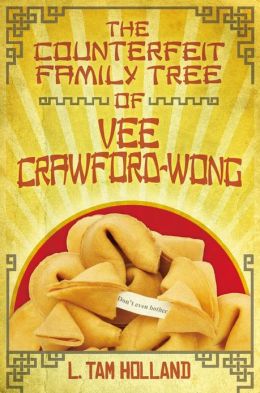 |
The Counterfeit Family Tree of Vee Crawford-Wong L. Tam Holland An assignment to write an essay on family history kickstarts a high school sophomore’s mission to understand his hyphenated identity in this funny and profane first novel. All Vee knows about his Texas grandparents is that their annual Christmas card always makes his mother cry; his father, meanwhile, left China for college and never looked back. Already in trouble for lackluster academics, Vee can’t get his parents to talk about their pasts, so he completes the essay by inventing a backstory for his father’s family in a fishing village along the Yangtze. After he gets away with that, he’s on a roll. The question of when Vee’s lies and machinations will catch up with him gives the second half of this novel some much-needed tension. Vee is intelligent and self-effacing, and he’s also the yin to Sherman Alexie’s yang. Whereas Junior in The Absolutely True Diary of a Part-Time Indian was determined to better himself despite poverty and a dysfunctional family, Vee is a privileged kid with wonderful parents who travels a long, tortured path to find there’s no place like home. 2013, Simon & Schuster, Ages 14 up, $17.99. REVIEWER: Publishers Weekly (Publishers Weekly). ISBN: 9781442412644 |
 |
Day by Day Susan Gal “Mile by mile, pigs motor west/ Brick by brick, pigs build a house,/ and piece by piece, it becomes a home.” In a porcine version of a 1930s-era migration, a family of pigs in period clothing arrives in a rural community and settles in. Writing in rhythmic free verse that recalls the “inch by inch, row by row” children’s song, Gal (Into the Outdoors) creates gaily colored spreads using digital collage, then fills them with friendly, hard-working pigs. The pigs harvest their first crop, then celebrate in a distinctly piggy way: in the book’s best moment, plump, rosy pigs strip down to lacy underthings and tighty-whities and race to the gigantic mudhole (“Layer by layer, pigs shed their clothes… and one by one, pigs cannonball!”). A spread shows the whole clan floating and snorkeling; in a sly A.A. Milne reference, a small pig clutches a toy Piglet (other literary pig references are tucked into the story for eagle-eyed readers). Comforting and conflict-free, the book’s sense of predictability makes it promising bedtime material. 2012, A Borzoi Book/Alfred A. Knopf/Random House Children’s Books, Ages 5 to 9, $16.99. REVIEWER: Publishers Weekly (Publishers Weekly). ISBN: 9780375869594 |
 |
The First Tortilla: A Bilingual Story Rudolfo Anaya Illustrated by Amy Cordova As the squash and bean crops of her family’s village begin to die from lack of water, Jade receives a fortuitous visit from a tiny blue hummingbird. The little creature convinces Jade that she must undertake a journey to the Mountain Spirit and ask for water for her village. Although her parents tell her it is too dangerous for a girl to survive such a trek, Jade knows that the Mountain Spirit is angry at her village for failing to make offerings. She therefore sets off with a gift to appease the controller of rain. Because of her bravery, Jade not only saves the village from drought but she also brings back a gift of her own from the mountain: corn. By drawing on an old Mexican legend, Anaya creates a new story with a female heroine that will entertain and instruct children about gratitude and bravery. Beautiful, colorful, and creative, the illustrations will delight readers as much as the text. A glossary at the end of the book helps readers understand some of the Spanish words used in the English version of the text. This book would make a good addition to any public or school library. 2012, University of New Mexico Press, Ages 8 to 11, $16.95. REVIEWER: Ramirose I. Attebury (Children’s Literature). ISBN: 9780826342157 |
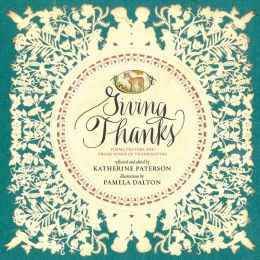 |
Giving Thanks: Poems, Prayers, and Praise Songs of Thanksgiving Katherine Paterson Illustrated by Pamela Dalton Paterson and Dalton, who collaborated on Brother Sun, Sister Moon, return with a wide-ranging and gorgeously executed collection of poetry, prayers, and other grateful musings fit for Thanksgiving or any time of year. Paterson groups her selections into four categories-celebrating food, life, inner spirit, and community-accompanied by Dalton’s trademark scherenschnitte scissor-cut illustrations, which are tinted with coffee and painted in watercolor (delicately cut beetroots, wheat sheaths, honeycombs, and berries appear within intricate panels in the “Gather Around the Table” section, for instance). Paterson pulls from a wide range of traditional and modern sources that include traditional proverbs and blessings from around the world, excerpts from the King James Bible, poems from the likes of Whitman and Dickinson, and even speeches and songs. She also points out that reverence and a sense of humor can go together, as in a haiku from Basho (“This snowy morning/ That black crow I hate so much…/ But he’s beautiful!”). A joyfulness of spirit permeates the compilation, underscoring Paterson’s early reflection that “joy is the twin sister of gratitude.” 2013, Chronicle, Ages 5 up, $18.99. REVIEWER: ★ Publishers Weekly (Publishers Weekly). ISBN: 9781452113395 |
 |
It’s All About Me-ow Hudson Talbott Our savvy feline narrator introduces newly arrived kittens to their humans with wry humor, advising them as superior beings on how to take control of their family. A Catwalk through history demonstrates how cool cats are. Since they offer “purr therapy” to the harassed modern family, cats know how to get their way no matter what they do. Their most important job is to play with their humans, never letting them forget that their cat is the center of their world. After advice on what to catch and not to catch, a catalog of the fabulous cat family depicts the “beautiful bunch of beasties” from cheetah to ocelot. Truly a cat’s life is “purrrr…fect.” The front of the jacket/cover depicts a trio of naturalistic wide-eyed kittens looking innocent; on the back a dozen cats are tearing a room apart. The double pages are filled with comic watercolor, colored pencil, and ink vignettes, bits of text, and feline interpretations. 2012, Paulsen/Penguin, $16.99. REVIEWERS: Ken Marantz and Sylvia Marantz (Children’s Literature). ISBN: 9780399254031 |
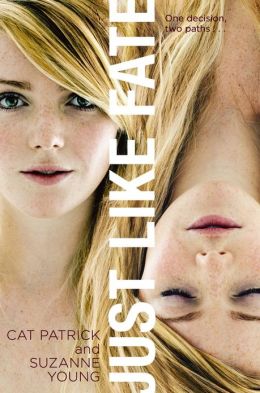 |
Just Like Fate Cat Patrick The concept of telling a story two ways–what if one thing changes, how would the story unfold– is not new, but Patrick and Young have done a wonderful job with this classic premise, producing a novel that this reviewer woke up at 5 a.m. to finish. The story begins as Caroline’s beloved grandmother, with whom she has lived for five years, has had a stroke. Gram is moved to hospice, and Caroline spends every minute she can at Gram’s bedside. Then, Caroline gets a call from her best friend, Simone, saying there is a party tonight, take a break, come out with us. Stay or go is Caroline’s choice. The story splits here, with chapters labeled “Stay” and “Go,” alternating over the few months to Thanksgiving. Gram dies within minutes of the choice. In “Stay,” Caroline starts out reuniting with her sister and her mother, and stays at her school. In “Go,” she moves in with her father, thirty minutes and a world away. Which decision is right, or mature, or what Gram would want slides back and forth as time progresses in both tales. In the end, it is the lead singer of her favorite band, in an interview describing a song, who explains both of Caroline’s stories: ” our mistakes don’t define us. They don’t derail us. We end up where we need to be in the end.” And so does Caroline. Novels with multiple authors and plotlines sometimes feel disconnected, like two novellas mashed together without an organic connection. That is not the case here. The two tales do not–cannot–mix, and yet the settings and characters are consistent between them, making the reader truly believe that there was a choice, but only one ending. This is a wonderful, engrossing book that has already won both authors a new fan. VOYA CODES: 4Q 4P J S. 2013, Simon Pulse, Ages 12 to 18, $16.99. REVIEWER: Beth Karpas (VOYA). ISBN: 9781442472716 |
 |
Kishka for Koppel Aubrey Davis Illustrations by Sheldon Cohen Kishka for Koppel is a retelling of the classic folktale of The Three Wishes, with a Yiddish twist. Koppel, a peddler by trade, is out collecting unwanted junk when he comes across a rusty old meat grinder. As he grumbles to himself for being so unlucky, the meat grinder speaks up, admonishing him for his negative thinking. The meat grinder tells Koppel he is here to help him and offers to fulfill three wishes. Koppel rushes off to share the news with Yetta, who, upon hearing the news shares Koppel’s excitement. Following the traditional storyline, the scene plays out. The ending is more satisfying than some retellings, in that Koppel and Yetta are able to take the lesson in stride and find humour in it. They indeed are lucky for the things they have in life. This interpretation of the traditional Three Wishes story is well done. Humorous dialogue and sprinkles of Yiddish idioms authenticate the narrative. The bold illustrations project a homey atmosphere in the story, making a suitable backdrop for this folktale. The pictures add to the humour of the tale as well as adding to its flow with colourful rick-rack page borders connecting the pages. The tale is further enriched with the addition of a Glossary at the end of the book, describing Yiddish terms and names used in the book. This feature makes the book more accessible to readers who might not be familiar with Jewish culture. This book supports Language Arts units on folktales and Social Studies units emphasizing communities and cultures. The book would be a suitable selection for both school and public libraries. Category: Picture Books. Thematic Links: Folktales; Three Wishes Read Alikes; Jewish Culture. Resource Links Rating: E (Excellent, enduring, everyone should see it!), 2011, Orca, Ages 2 to 9.$19.95. REVIEWER: Linda Berezowski (Resource Links). ISBN: 9781554692996 |
 |
Praise Song for the Day: A Poem for Barack Obama Elizabeth Alexander Illustrated by David Diaz The poem that creates the narrative for this beautiful picture book was commissioned for the inauguration of President Barack Obama. The essence of the poem is that too often, we take little time to celebrate the concept of love and what our world might be like if we spent more time focused on our appreciation of our ancestors, our families, our friends, and those we come into contact with on a daily basis. The poet begins by noting that on most days, people stream past other people in a noisy mix that leads all of us to various jobs, activities, interactions, and hopes. Taking the time to understand what we accomplish each day and what our ancestors accomplished before us may help all of us move towards a better tomorrow for all of us. The illustrator does a phenomenal job capturing the language of the poem with his use of bright colors, slightly abstracted character types, and recognizable shapes and patterns that create their own energy page by page. This would be a lovely addition to any collection of picture books. 2012, Katherine Tegen, Ages 6 to 10, $16.99. REVIEWER: Jean Boreen, Ph.D. (Children’s Literature). ISBN: 9780061926631 |
 |
Running Dream Wendelin Van Draanen Running is Jessica’s life. A talented track star with plenty of potential, she was hoping for a sports scholarship to college but when the team’s bus collides with a car, Jessica’s running career is over. Her right leg, shattered beyond repair, is amputated below the knee. Adjustment to life without her leg is difficult, and her nightly dreams about running are bitter reminders about what she has lost. Unable to walk, much less run, Jessica returns to school feeling hopeless and that her life is without meaning. While small victories and new friendships help take the edge off her frustrations, it is not until she sees YouTube videos of amputee athletes competing professionally that Jessica truly believes she might be able to run again. Readers seeking a gentle inspirational story about a girl overcoming adversity will not be disappointed. Jessica’s leg heals quickly and her emotional journey is one of gratitude and positive thinking rather than depression and self pity. Her narrative of her life as an amputee, especially the details of getting her prosthesis, are frank and fascinating. Her emerging friendship with Rosa, a student with Cerebral Palsy who uses a wheelchair, is a convenient device for bringing awareness to the invisibility of the disabled, but it fits with the upbeat tone of the book. Although the characters are slightly bland and there are few surprises here, Van Draanen has created an engaging story about friendship and inner strength that teaches as it inspires. VOYA CODES: 3Q 3P J S . 2011, Knopf, Ages 12 to 18, $16.99. REVIEWER: Summer Hayes (VOYA). ISBN: 9780375866678 |
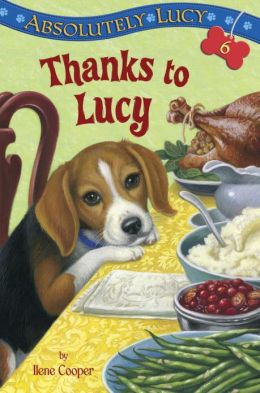 |
Thanks to Lucy Ilene Cooper Illustrated by David Merrell Third-grader Bobby has his hands full. His parents want to adopt a baby; the Thanksgiving school program is coming up; guests are arriving for the holiday-and there seems to be something wrong with his beloved beagle puppy, Lucy. How Bobby, a shy boy with a talent for drawing, copes with all these problems is the basis for this charming book, the sixth in the “Absolutely Lucy” series. Bobby and his family are portrayed as real people living ordinary lives. They may not be perfect, and they might make mistakes now and then, but they are doing their best to help and love one another. The author does an excellent job of using the plot to reveal Bobby’s kindness, as well as his uncertainty about the big changes coming in his family. For example, in the middle of coping with his beagle’s illness, and with the pressure of the Thanksgiving program, Bobby discovers what it takes to be a good big brother. And he also learns that caring for others-including your dog-is one of the most important things in life. The gentle humor and warmth of this chapter book is hard to overstate. The illustrations are sparse and done in tones of gray, but they complement the quiet, easy rhythm of the text. Parents, teachers, and children alike are bound to be entertained by this installment of the “Lucy” series. Readers do not need to start with the first “Lucy” book to enjoy this one. Teachers, however, will probably want to present the entire series, from the beginning, in their classrooms. 2013, Random House, Ages 7 to 9, $4.99. REVIEWER: Leona Illig (Children’s Literature). ISBN: 978-0-375-86998-3 |
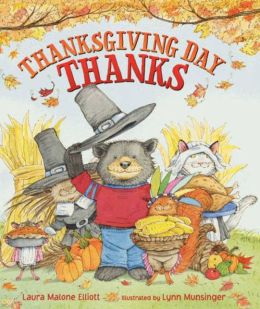 |
Thanksgiving Day Thanks Laura Malone Eliott Illustrated by Lynn Munsinger Sam the bear, previously seen in A String of Hearts (2010), struggles to figure out what “one special thing” he’s thankful for as his classroom gears up for a Thanksgiving celebration. Sam’s classmates are grateful for football, shopping, and marshmallow-topped sweet potatoes, and as Sam considers his answer, Elliott incorporates an array of holiday activities into the story that will be a boon for teachers and families alike: creating placemats from wax paper and autumn leaves, donating to food drives, and making bead necklaces to represent wampum, among others. Munsinger is, as usual, attentive to the emotions of her anthropomorphic animal cast, and at Sam’s lowest (when his parade-ready balloons nearly fly away), a classmate’s quick thinking-and good aim-help save the day. While Sam’s eventual realization of what he’s thankful for (his family) won’t surprise anyone, Elliott does a commendable job of including a great deal of information about Thanksgiving history into the story and in endnotes, including a bit of Wampanoag vocabulary and some guesses as to the menu of that first 1621 feast. 2013, HarperCollins, Ages 4 to 8 $17.99. REVIEWER: Publishers Weekly (Publishers Weekly). ISBN: 9780060002367 |
Thanksgiving
 |
While America celebrates Thanksgiving Day in November, it is celebrated on different days around the world. Our book selections reflect a sense of gratitude as well as more “traditional” Thanksgiving fare. View Thanksgiving book recommendations from previous years at http://clcd.com/index.php/nlindex. Web links to additional information and activities about Thanksgiving and gratitude follow these reviews. Contributor: Peg Glisson |
Reviews
|



